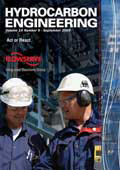Editorial comment
While the deepest recession since World War II maybe coming to an end, US refiners need to brace themselves for what is ahead.
Register for free »
Get started now for absolutely FREE, no credit card required.
While the deepest recession since World War II may be coming to an end, US refiners need to brace themselves for what is ahead.
The spike in gasoline prices to US$ 4/gal. in mid 2008 and the subsequent drop in fuel demand showed that US drivers were willing to reduce their fuel use in a dramatic fashion. The financial meltdown and recession that followed further reduced the demand for transportation fuels and helped usher a Democrat into the White House with a mandate for change.
For refiners, the mandate has resulted in a flurry of legislation, which will likely have a significant impact on the US refining industry by:
- Putting more fuel efficient cars on the road sooner.
- Mandating the use of renewable fuels that directly displace a portion of the gasoline and other fuels produced by refineries.
- Reducing carbon dioxide emissions with a complex system that will increase the cost of refining and result in higher pump prices.
Taken together, these actions will turn the demand curve for gasoline and other petroleum based transportation fuels upside down. An estimate from the US Department of Energy’s Energy Information Administration (EIA) in April shows the amount of fuel sold in the US to power cars and trucks will drop nearly 13% between now and 2030. Depending on how legislation regulating carbon emissions plays out in Washington, things could turn out even worse.
The Waxman-Markey bill passed in June by the House clearly has US refiners in its crosshairs. First, the bill puts domestic refiners at a competitive disadvantage to international refineries by requiring the purchase of carbon allowances for approximately half of the carbon emitted by an operating refinery. Secondly, it establishes the refinery as a point of regulation for all the carbon emissions contained in the gasoline and other fuel products it produces. A typical 120 000 bpd refinery would thus be required to purchase carbon allowances of over US$ 300 million annually, assuming just a US$ 20/t carbon allowance price. Guessing wrong on when and at what price to purchase these allowances could result in losses that easily dwarf the average refinery’s yearly operating margin.
As the impact of the recently proposed or enacted regulations is realised over the next several years, up to 2 million bpd of crude processing capacity in the US could be eliminated.
Which refineries will survive? Modern mega refineries capable of adjusting to a wide range of crudes are likely to remain strong players. But size and complexity are not the only determinants of success. Efficient operations, an advantaged crude supply, and access to product markets not easily served by others have always been a winning formula. This will be doubly important in the coming years.
However in the new environment, even more is needed. Carbon management capabilities are necessary to facilitate strategic decisions and ensure regulatory compliance. The price of carbon needs to be clearly embedded in the refinery operating models and capital investment plans. This requires the development of the requisite infrastructure to support the needs across a refining network.
Although somewhat ironic, refiners can also leverage their operations expertise and capital to embrace the regulations designed to significantly reduce the use of petroleum fuels. While the US market for petroleum based fuels will likely shrink over the next 20 years, renewable and low carbon fuels represent a growth market. Some refiners have already begun to capture more of the emerging value chain and it is reasonable to expect more of this as the plethora of regulations become effective.
In the final analysis, however, take heart: refiners have always proven to be a very resilient bunch. Over the last 35 years they have survived several industry shakeouts resulting from the workings of a free market, as well as those created through government mandates and regulations. No doubt, they will emerge successful from the current onslaught of regulatory driven change.

